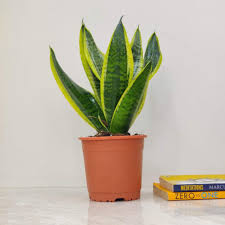The Complete Guide to Mother-in-Law’s Tongue: Care, Benefits, and Indoor Appeal
Introduction
Mother-in-Law’s Tongue, also commonly known as Snake Plant or Sansevieria trifasciata, is one of the most popular houseplants worldwide. Renowned for its unique vertical leaves and low-maintenance nature, this plant offers both aesthetic and practical benefits. Its nickname is inspired by its sharp, upright leaves, symbolizing the proverbial “sharp tongue” of a mother-in-law. Whether you’re new to indoor gardening or looking for a stylish, resilient plant, Mother-in-Law’s Tongue is an excellent choice for any home or office space.
Striking Appearance and Varieties
The most eye-catching feature of Mother-in-Law’s Tongue is its stiff, sword-shaped leaves that grow vertically from the base. These leaves are typically deep green with yellow or silver-green variegation, creating a bold, architectural look. The plant is available in several varieties, from the classic tall Sansevieria trifasciata to the shorter, rosette-shaped Sansevieria hahnii. These different forms allow for creative design and placement, whether in small pots on shelves or as statement floor plants.
Health and Environmental Benefits
One of the top reasons people love Mother-in-Law’s Tongue is its powerful air-purifying qualities. According to NASA research, it helps remove toxins like formaldehyde, xylene, and benzene from indoor air, improving air quality. Unlike many plants, it releases oxygen at night, making it ideal for bedrooms where clean air is essential during sleep. Additionally, the plant adds natural humidity to indoor environments, promoting a healthier living space.
Simple Care Requirements
Mother-in-Law’s Tongue is famous for being nearly indestructible, making it a perfect plant for beginners or those with busy lifestyles. It thrives in a wide range of light conditions, from bright indirect light to low light areas. However, for optimal growth and vibrant colors, indirect sunlight is best. Watering should be infrequent—allow the soil to dry completely between watering to avoid root rot. This plant also tolerates a variety of indoor temperatures and requires minimal fertilization, usually just once during the growing season.
Common Issues and Maintenance Tips
Although it’s a hardy plant, Mother-in-Law’s Tongue can occasionally face issues. Overwatering is the most common problem, often leading to yellowing leaves or mushy roots. Always use well-draining soil and a pot with drainage holes. Pests like mealybugs or spider mites may appear but can be easily removed with a gentle insecticidal soap or by wiping leaves with a damp cloth. Keeping the plant clean and dust-free also promotes better health and appearance.
Conclusion
Mother-in-Law’s Tongue is a timeless favorite among houseplants due to its striking looks, air-purifying abilities, and effortless care. Its adaptability to various conditions and minimal maintenance needs make it an ideal choice for anyone looking to add greenery to their home without the hassle. Whether placed in a modern living room, a cozy bedroom, or an office corner, this versatile plant is sure to thrive and enhance any indoor space.




